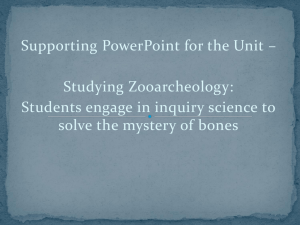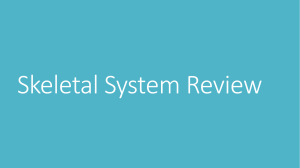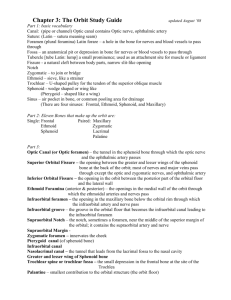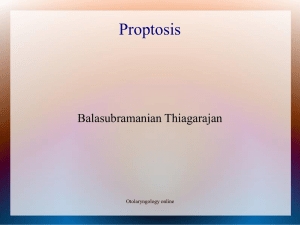Cummings Chap 23 Maxillofacial Trauma
advertisement
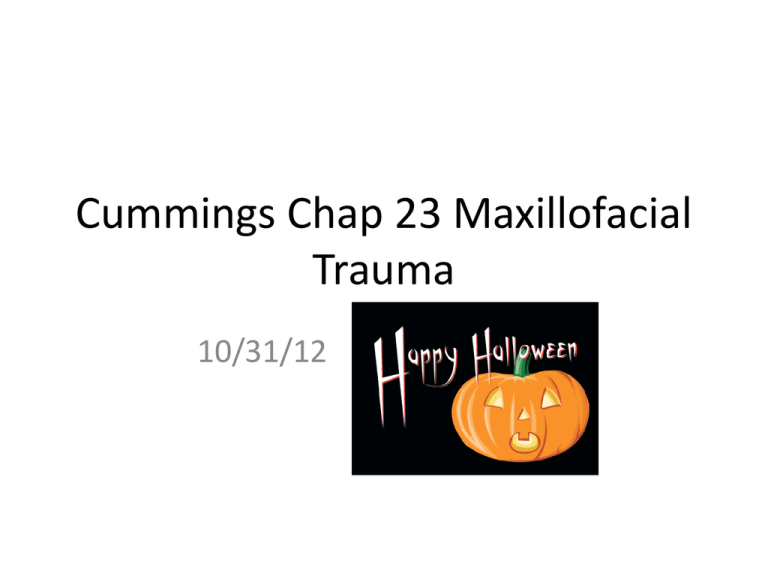
Cummings Chap 23 Maxillofacial Trauma 10/31/12 Anatomy/Physiology Upper 1/3 • Frontal bones- “relates” to FS, brain, orbits, cribiform, supratrochlear/supraorbital n Middle 1/3 • Zygoma- facial projection, masseter insertion, inferolateral orbital rims/walls • Orbits- 7 bones (frontal, zygomatic, max, lacrimal, ethmoid, sphenoid, palatine). • maxilla- V2, infraorbital rims/floors, NLD, teeth, MCL • nose- breathing/olfaction, cosmesis – Most freq fx bone in human body Anatomy/Physiology Lower 1/3 • Mandible – Dentition/occlusion – Horseshoe shape + TMJ absorbs force from transmitting to MCF – 32 teeth, 8/quadrant – Angel Classification of occlusion • Class I mesiobuccal cusp of max 1st molar sits in buccal groove of the mandib 1st molar. • Class II max molar more anterior/chin retruded- overbite • Class III max molar more posterior/chin prognathic- underbite Eval/Diagnosis PE • ABCD, gen appearance, CNs, Blood/CSF, FB Upper 1/3 • Test motor, sensation, step offs Mid 1/3 • Eval globe/orbits, visual acuity, EOMs, proptosis/enopthalmos, ophthal consult • Nasal bone- fx, septal hematoma, NOE • NOE fx- Intercanthal distance- normal 30mm, ½ interpupillary distace, >45mm=telecanthus, loss of nasal dorsal height, epicanthal folds, MCL traction test Lower 1/3 • Open mucosal teas, V3 sensation, occlusion, mouth opening/trismus. Radiographic Eval Axial cuts- good to eval FS, zygomatic arch, vertical orbital walls, vertical structures Coronal cuts- good to eval orbital roof/floor, pterygoid plates, horizontal structures CT face w/ fine cuts 1.5mm Schemas Upper 1/3 • FS fx – – Ant table- cosmesis, sinus function – post table- sinus fxn, neurosurg • Supraorbital rim comminuted fx FS recess injury • Centrally located + severe fx CSF leak Mid 1/3 Orbits – Orbital apex syndrome- II, III, IV, V, VI – Superior orbital fissure syndrome- III, IV, V, VI – Blowout fx- rims intact w/ 1 or more walls fx, usu floor/medial wall Le Forte NOE Schemas Le Forte ?- complete craniofacial separationzygoma, through orbit, nasaofrontal jxn Le Forte ?- horizontal max fx above dentition Le Forte ?- pyramidal fxorbital rims/floor, nasal root Schemas Le Forte I- horizontal max fx above dentition Le Forte lI- pyramidal fxorbital rims/floor, nasal root Le Forte III- complete craniofacial separationzygoma, through orbit, nasaofrontal jxn Schemas • Type ? bone fragment containing MCL freed from surrounding bone • Type ? MCL tendon detached or attached to a fragment that is irreparable ie bilat orbital wall fx • Type ? comminuted fx, repairable via transnasal fixation Schemas • Type I bone fragment containing MCL freed from surrounding bone • Type II comminuted fx, repairable via transnasal fixation • Type III MCL tendon detached or attached to a fragment that is irreparable ie bilat orbital wall fx Management- access • Start ppx abx immed Surgical access- existing lac? Upper 1/3 • Coronal incision, access to pericranial flap, beware frontal br and supraorbital n Mid 1/3 • Zygoma- gilles, gingivobuccal • Lateral orbital rim- upper bleph, lateral brow, lower lid transconjunctival +/- lateral canthotomy • Orbital floor- transconj pre v post septal, transcutaneous subciliary v lower lid crease (frost stitch) • Medial orbit- transcaruncular, lynch Lower 1/3 • Mandible- intraoral, beware mental n, transcervicalsubmand/submental incision, retromandib inci, beware mental n, facial n. Biomechanics Facial skeleton has areas of strength and weakness Strength- buttresses/pillars Weakness- crumple zones eg. LP/ethmoid bones- direct blunt trauma to central face telescoping NOE fx, dissipates force protecting globes. Same concept for purpose of sinuses. Biomechanics Upper 1/3 • frontal ant table- weak • supraorbital rim- strong, protects orbits and ant cranial fossa Mid 1/3 • vertical buttress x4: nasofrontal/nasomax, frontozygomatic/zygomaticomax, pterygoid • horizontal bars x4: frontal bar, zygoma, infraorbital rim, palate Low 1/3 • Mandible upper beam- tension forces • Lower beam- compressive forces Fracture Repair- principles Purpose of fx repair- regain aesthetic form and occlusal fxn Rigid fix- elim movement across fx, allows primary bone healing, minimizes callus formation Occlusion>>fracture reduction MMF, ivy loops, IMF- to re-est occlusion Work from stable to unstable, known to unknown, periphery to center Re-est facial height 1st -repair mandible 1st, make sure midface not impacted/rotated before rigid fixation Then stabilize buttresses- L/J plates Then central face Then orbits- floor has irregular convexity, not a complete sphere, failure to recognize will cause enopthalmos Repair CSF leaks immediately, longer leak incr r/o meningits Mandible fx repair 2 schools 1) Champy- miniplates + monocortical screws 2) Speisl- MMF + compressive plate w/ bicortical screws Body- single miniplate +/- bicortical compression plate Symphysis- 2 miniplates Angle- very complex/changing forces, recon plate v single 1.3mm miniplate v 2 2mm miniplates, highest rate complications Ramus- 2 2mm miniplates Subchondylar- MMF v open- risk to FN indications for open– – – – chondylar displacement into MCF inability to obtain reduction lateral extracapsular displacement of chondyle FB Relative indications– B chondylar fx + edentulous, + comminuted midface fx, +gnathologic problems – when splinting not recommended Mandible fx repair Load sharing- depends on integrity of bone, eg miniplate, compression plate, lag screw Load bearing- atrophic/thin/comminuted fx- repair needs to bear load across the affect bone eg recon plate w/ 4 bicortical screws on each side. Fall-back technique for all repairs Locking (v nonlocking) screws allows for less than perfect plate bending. Other options: • ex fix, MMF 4-6 wks Tooth in fx lineleave alone if: healthy, 3rd molar in angle fx remove if: infected, interferes w/ reduction Frontal Sinus Fx Anterior wall nondisplaced- obs Anterior wall displaced- repair Anterior wall + FSR injury- oblit v obs Posterior wall nondispl +/- FSR- obs Posterior wall displ- trephine + transcut endoscopy (r/o herniated brain) Obliteration- pack w/ fat, seal recess w/ cement or pericranial flap Cranilization- removal of posterior table NOE repair Type I- stabilize the floating bone to surrounding bone w/ plate Type II/III- stabilize MCL to the contralat frontal bone or MCL w/ permanent suture or wire Complications Malocclusion Continued movement across a fx leads to: • nonunion- persistent gap/fx • fibrous union/pseudoarthrosis- persistent callus w/o bone formation • malunion- bone heals in wrong position Scar Entropion/extropion Nerve injury




